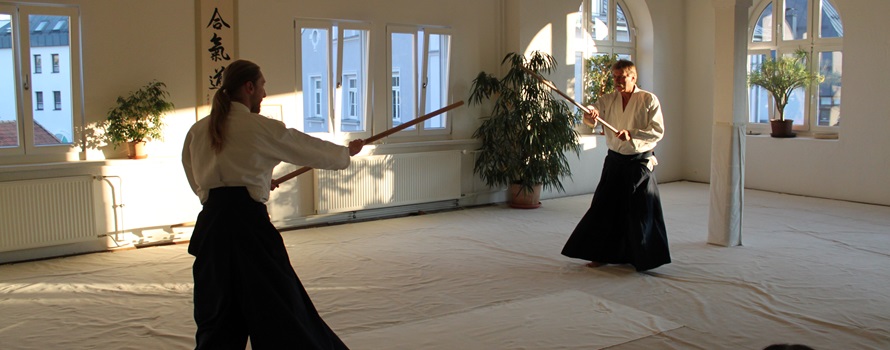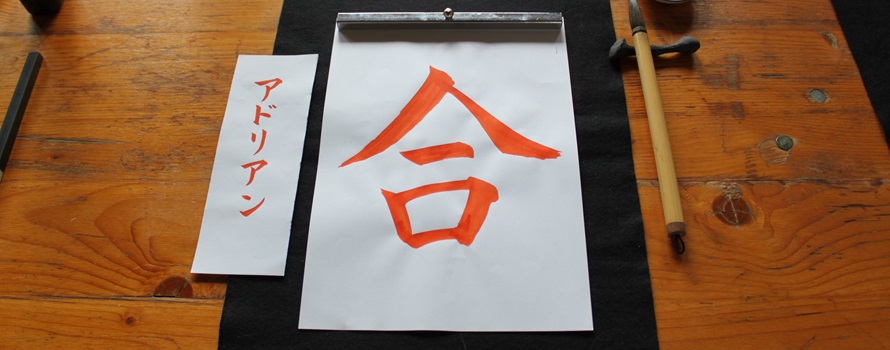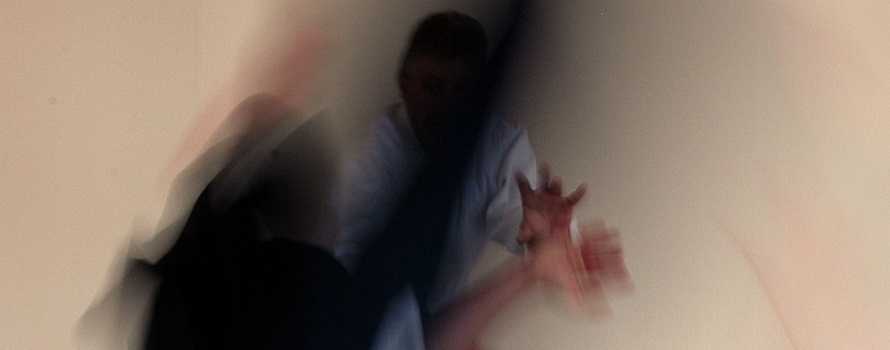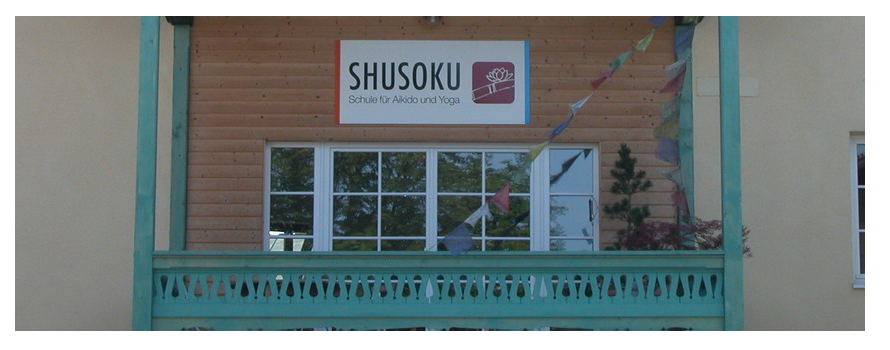On the occasion of the 25th anniversary of Rosenheim‘s Shusoku Dōjō, we received a visit from Horst Schwickerath, the editor of Aikidō Journal. We talked about the history of the Dōjō and Doris Wiedenmann and Jochen Maier‘s Aikidō careers, from the early beginnings in Ulm up to the organization of the International Aikidō-Seminar in Bernau am Chiemsee. The interview was recorded by H. Schwickelrath and turned into running text with the assistance of J. Maier. It was published in AJ issue #96.
I
The early years and the great seminars up to the founding of the Dōjō in Rosenheim.
I started practicing Taekwon-Do with Ulrich Michael, at his “Sportschule Michael” in Ulm. U. Michael was known as a specialist for Taekwon-Dō and Ju-Jitsu, but he was also interested in Aikidō. He had studied Aikidō at seminars with Tada Sensei in Italy. One day some of Mr Michael‘s students were invited to try Aikidō. I was among them, and Aikidō fascinated me from the very first moment. So around 1977 a small Aikidō group formed at his Dōjō.
At those first lessons with the Aikidō group in Ulm I met Mr Tornow, an honorable gentleman in his sixties. He had good contacts to Japan since he had worked as a manager for Asian affairs for a big multinational company. Therefore making contact with Aikidō masters in Japan was easy for him. By the way Hannes Tornow used to teach Yoga long before anybody could imagine today‘s Yoga boom…
About one year later Doris finished boarding school and joined me in Ulm. She also started practicing Aikidō. At that time we lived in a small town near Heidenheim. Sometimes we took our beautiful, brand new red motor scooter to get to the Dōjō in Ulm about 30 km away. That was not always a good idea, especially in bad weather, so I soon purchased an old beat-up Peugeot 204 that was indestructible and served us well. What a pity that I sold that motor scooter, it would have made a great vintage vehicle by now.
Inspired by Mr Tornow I visited Tada’s seminars in Le Brassus/CH. (Tada started teaching seminars there in 1965). Mr Tornow was a friend of Tada’s and he introduced us. I also met Hans-Jürgen Klages and Heinz Patt in Le Brassus. I had already known Klaus Broscheit from his seminars in Ulm and Munich. When the seminars in Le Brassus stopped, we went to Tada’s seminars in Coverciano near Firenze to practise. We also went from Ulm to Hachen where Yamada Sensei taught seminars organized by Klaus Broscheit.
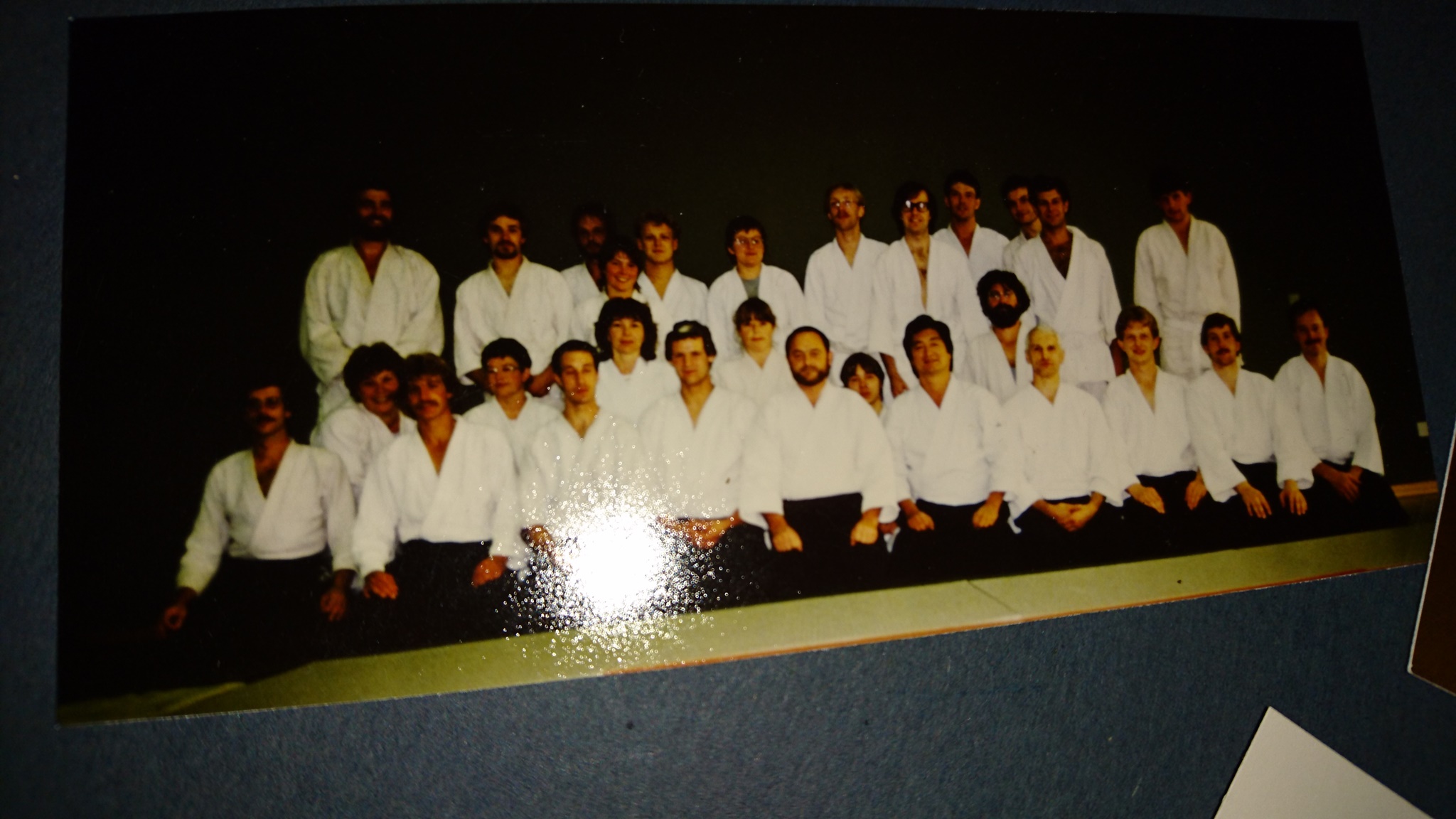
Seminar with Yamada Sensei in Hachen (Germany).
On the weekends we attended the seminars of Asai Sensei, who at that time was also teaching seminars in Ulm. Yes, I learnt a lot from Asai.
These first seminars, especially the international seminars with Tada Sensei were the initial spark that really started my fascination for Aikidō.
Then we started our studies. Doris wanted to study interior architecture in Rosenheim and I chose geography in Munich. Therefore we both moved to Rosenheim. In the beginning I commuted from Rosenheim to Munich to attend my lectures and registered at the recently founded Dōjō of Heinz Patt. Later I moved into a little student apartment where I stayed on weekdays. Of course Doris finished her studies much faster than I. We rented an apartment in Munich and lived there until we founded our own Dōjō in Rosenheim.
During my studies I practiced almost daily at Heinz Patt’s Dōjō in Munich – from where we started for Yamada’s and Tamura‘s seminars in La Colle s/Loup. At that time Yamada taught the first week of that seminar alone, Tamura only joined him during the second week.
The training in La Colle took place in a tiny sports room, used by the WWF for animation purposes. It was terribly small. Soon they founded the big open-air Dōjō. Now there was plenty of room but the training was very tough in those first years. There were only a few participants, lots of room and it was Yamada who lead the training for an entire week.
Our time in Munich and the subsequent years until Tamura Sensei‘s passing were marked by the summers in La Colle.

La Colle sur Loup.
and many seminars with Tamura all over Europe. I especially remember the first seminars in Budapest – at that time the Soviet block still existed – that means before it was 1989…
Of course I also practiced in New York, USA, – What a city…certainly a great destination for holidays but I would not want to live there.
II
The history and development of our Dōjō in Rosenheim
In 1993 we founded our Dōjō in Rosenheim – and this year we are celebrating the 25th anniversary…
The rooms had a special atmosphere from the very start, but were in poor shape. First we had to take out dirt, construction rubble and dust of decades in order to start renovating – we spent endless hours working our fingers to the bone.
Of course Rosenheim is not Munich and we had to face the difficult question of how to attract enough members and create enthusiasm for Aikidō.
Tamura told me, “Why don’t you move to Berlin?“ The next time he suggested Hamburg. But we did not want to live in a large town. We wanted nature and the mountains nearby, that to us is quality of life …
The number of potential Dōjō members in Rosenheim might be smaller than in a metropolitan Dōjō but on the other hand the rent for our facilities is a bit lower, too. Without thinking about the consequences I signed a rental agreement for 10 years. We were very inexperienced in those things and luckily everything went fine. But I would not recommend this strategy to anyone. I had all further rental agreements checked by a friend of mine who is a lawyer.
Doris has been an integral part of the Dōjō from the very beginning. We built it up piece by piece and turned it into what it is today. Soon we got some very good students who could take proper Ukemi and thus positively influenced our lessons. Doris also taught lessons which helped a lot. So I could travel during the weekends, teach seminars or take part in advanced seminars.
At the same time (1993) we started offering Yoga lessons. Yoga is also one of my passions. During my time in Munich I took Yoga lessons and practiced daily at the Sivananda-Yoga-Vedanta-Centre.
I had great hopes for this second mainstay as well. The first lesson I taught was sobering: There were only 2 participants!
But by 1994, after I had finished my studies as a Yoga teacher, the number of students in my Yoga lessons had increased significantly.
At that time the regular Yoga lessons and the seminars for Yoga beginners took place before or after the Aikidō lessons because there was no other space. That‘s why in the year 2000 we added another room to our premises which enabled us to offer Aikidō and Yoga at the same time. A bit later, in 2005, our school grew again: we added a big Yoga room. That again meant an incredible lot of work, but this time we did not do everything by ourselves.
And one of our most cherished wishes came true: We had the historic balcony renovated by a specialist. I am proud of that because the balcony has become like a symbol for our school.

The premises now consist of the Aikidō-Dōjō, the room for Yoga plus balcony, and a lounge for having tea including Doris‘ little Aikidō and Yoga shop. Last but not least we rented an office and a storage room for the mats we need for our big seminar in Bernau.
While our school was growing Doris took an external Yoga teachers‘ seminar and now also teaches beginners as well as our regular Yoga lessons. And when I finally offered the first seminar for Yoga teachers in our school she assisted as well.
It was an important mile stone for our school to be certified as a training center for Yoga teachers. We have been holding this certification for 10 years now, another anniversary to celebrate and to be proud of. In autumn 2018 the 11th seminar for Yoga teachers took place. What is still quite new but already facing increasing demand is the seminars for advanced Yoga teachers. Some of the teachers who teach Aikidō and Yoga at my school were trained right here.
III
Aikidō and Yoga complement each other
Recently a young colleague asked me if we also suffered from the „Aikidō disease“.
He alluded to the “crisis“ of the shrinking number of members.
“No,“ I was happy to report, the number of our members increases slightly. There are young people who want to practice and really learn. As they grow older some of my students from the teenage group join the regular lessons for grown-ups. It is important to have a sound basis and members of all ages.
It looks like classic Budō struggles for new members. Kids and teenagers join in but only few grown-ups. I think that due to the way people are striving for quick success and always expect simple solutions. Perseverance for years and maybe even decades to learn an art is scarce and doesn’t seem to be a worthwhile goal. The same is true for Yoga.
The amount of knowledge required from people in their studies or jobs keeps increasing. Students are more and more stressed and people in their jobs face a workload too great to be managed. Thus, spare time for learning “useless“ things is scarce.
Then, there are fickle trends that are deemed “hip“ and “in“.
Our image of Japan has suffered over the years and certainly did not improve by the management of the catastrophe in Fukushima.
During the eighties many people knew Zen, Shiatsu or Ikebana. Today when I ask my Yoga students about those things they only reply: „Zen? Never heard of it! Shiatsu? No idea! People know osteopathy…. Aikidō? Has to be something quite exotic.“
What can be done? Certainly there is no simple answer. But it is essential to go on and offer interesting and attractive lessons.
Young people want and are expected to stir up things - by the way: that applies to the older ones as well. Burying one‘s head in the sand and complaining does not help. Neither does a pompous functionary system in associations that hinders young and talented teachers and tries to impose artificial structures.
To adapt Aikidō completely to the western lifestyle won’t do any good. The small Japanese rituals and traditions that are associated with Aikidō are well received especially by young people.
I recently gained the impression that here in Germany Japan and all things Japanese are coming into fashion again. A country striving to balance tradition and modern life.
We are fortunate with our well-balanced mix of Aikidō and Yoga. In the beginning we had more Aikidō members than Yoga students, but that has changed over the years. Recently the number of Yoga students has increased significantly but Aikidō keeps up. Nevertheless we cannot sit back and relax – in 1995 Yoga was scarce, today you can find Yoga centers at every corner. Even my own Yoga students having completed the teachers training start being competitors. It’s a dynamic of its own.
We are at an advantage since our school has been known in Rosenheim for 25 years. Some of our students represent the third generation of their family practicing Yoga here, at „Am Roßacker 7“. I fondly remember when a 13-year old girl signed in her stressed out mom for Yoga and decided to join herself as well.
Overworked students from schools and colleges in need of relaxation also like to take our Yoga lessons.
By the way: (little) Rosenheim will soon become a University Town! That is a very prestigious title for a German town and we are happy to offer Aikidō and Yoga here of all places.
If we were to try and make a living of Aikidō alone I think we would not always be able to make ends meet. But Yoga as a second source of income enables us to practice Aikidō in peace without desperately having to hunt for members.
There is always an up and down. In the first five years everyone is motivated – that is natural. When times get rougher the risk of being discouraged is high. At that point it is important to have new ideas, to start over again with new strength and motivation. Of course, that requires a lot of energy and passion. If it was for the mere profit I would have to find another job. Of course I hope that business keeps increasing but that does not only depend on me. External circumstances like trends and fashion hypes influence every freelancer. Therefore your own personality is important, everyone is the architect of his own fortune – giving and receiving.
Even Yoga has changed over the years. Many new styles have evolved. People have developed new styles from details of classic Hatha Yoga, the so called modern Yoga styles. In my opinion, frankly spoken, this is often just some kind of gymnastics with elements of relaxation.
When talking about the Yoga tradition (thousands of years old) people usually mean the philosophy of Yoga (one of the classic systems of Indian philosophy) as well as the Vendanta (mental basis of Yoga).
Yoga as exercise for the body was only discovered in medieval times. And today’s form of Yoga only arrived in Europe and America in the sixties. Of course Yoga has developed further; that’s a process, a „world heritage“ of structures. See it for what is in it and do not always put it in a context. Things you might choose for yourself do not necessarily create feudal structures.
IV
„Respect“ and the philosophy of the „other“ – Exchange of cultures
Aikidō teaches us to accept and respect others. This should not be underestimated. If people really integrate this into their daily life it is something positive and something that is hard to be found nowadays. Reflecting on our attitude towards others – or even further – on a mindful use of the earth‘s resources, on nature itself. Respect and politeness, also part of Aikidō, are an essential aspect of our personal development and education. That does not mean submissive bending over in front of authorities. We had plenty of this in our history. I am talking about a much more refined and reflective form of respect, about acceptance, not ignorance.
The big seminars attended by people from all over Europe contribute to this. At our Bernau seminar we meet many people from Eastern Europe. But recently we also register participants from Italy and France. And of course I am especially happy about the young Aikidōka from Bavaria and southern Germany. We encounter many different nationalities and a fruitful, lively exchange of cultures. On a micro level only, but nonetheless…
Early on in my Aikidō career I had the great opportunity to meet some very interesting people from Japan and talk to them about their culture. During my Aikidō time in Ulm a young mathematician practiced with us. He was married to a Japanese. She was a master of Ikebana, could host tea ceremonies and had lived and practised with a famous Zen master until he passed away. Our conversations and discussions were a great chance to get a first-hand insight into their different ways of thinking.
No one can ever completely understand a foreign culture, or even their own, really. For it is made up of people with different personalities who act according to those personalities, their experiences and socialization. For me it has always been interesting to deal with new cultures. That’s why I studied geography.
It is important to confront the “foreign“ and the “own“, so that the “foreign” can become the „other“ - from there it is only another small step to the “own“
Cultures influence each other; they integrate positive or negative things from a foreign culture – or they don‘t. You don‘t have to try and change things or exert dominance. You just look at the other way of life and reflect on your own.
I am a big fan of the Japanese author Haruki Murakami. One of his novels deals with Platon’s system of ideas. It is just great! Two worlds melt together on an intellectual level but do not at all give up their cultural identity.
A journey to Japan is certainly interesting and a flight ticket today costs only a fraction of the amount I would have paid when I started with Aikidō. But I think that practicing Aikidō delivers a better insight into this country, its people and their way of thinking than a short vacation trip to this exotic country. And if you manage to have a good contact to an Aikidō master it is something meaningful. My conversations with Yamada and Tamura allowed for an insight into the Japanese way of thinking and acting – to certain limits but it prospers by taking and giving….
Even my first meeting with Yamada was very relaxed and friendly. He was sitting in Klaus Broscheit‘s living room in Bonn when I arrived. There were no boundaries. We talked and then we all went to the seminar in Hachen. Yamada went with me in my car, that was very familial, too. It was different to what I had encountered before with Tada or Asai, they had kept their distance.
Of course we all held Yamada in high regard and had great respect for him, but it was not forced upon us, nothing exaggerated. We simply called him “Sensei“, he did not ask for it. Also Tamura liked it familial, a back-slapping, a smile or a question, just normal. It turned into a reciprocity and stayed that way.
At that time in Hachen there were not as many participants as today, so we all took Ukemi for Yamada often and got close to him very soon. There already existed an inner circle and soon Doris and I became members of that “family“.
V
Bernau
Then came what one would today call the „Bernau-Project“. Year after year we have been building up that seminar. In the beginning we registered lots of participants but unfortunately their numbers decreased. Just to rise again slowly but constantly until the seminar was really well attended.
It was important that not only Yamada and I taught there. If we met a high ranked participant from the USA or from Europe in Bernau, we asked him or her to teach. We tried to integrate them by letting them teach at our seminar. Those people often returned the next year and brought along some of their students. So Bernau turned into a truly international seminar which had been our intention from the very beginning. We wanted to offer the lessons in the afternoon to many teachers, not just to one or two - Sharing!
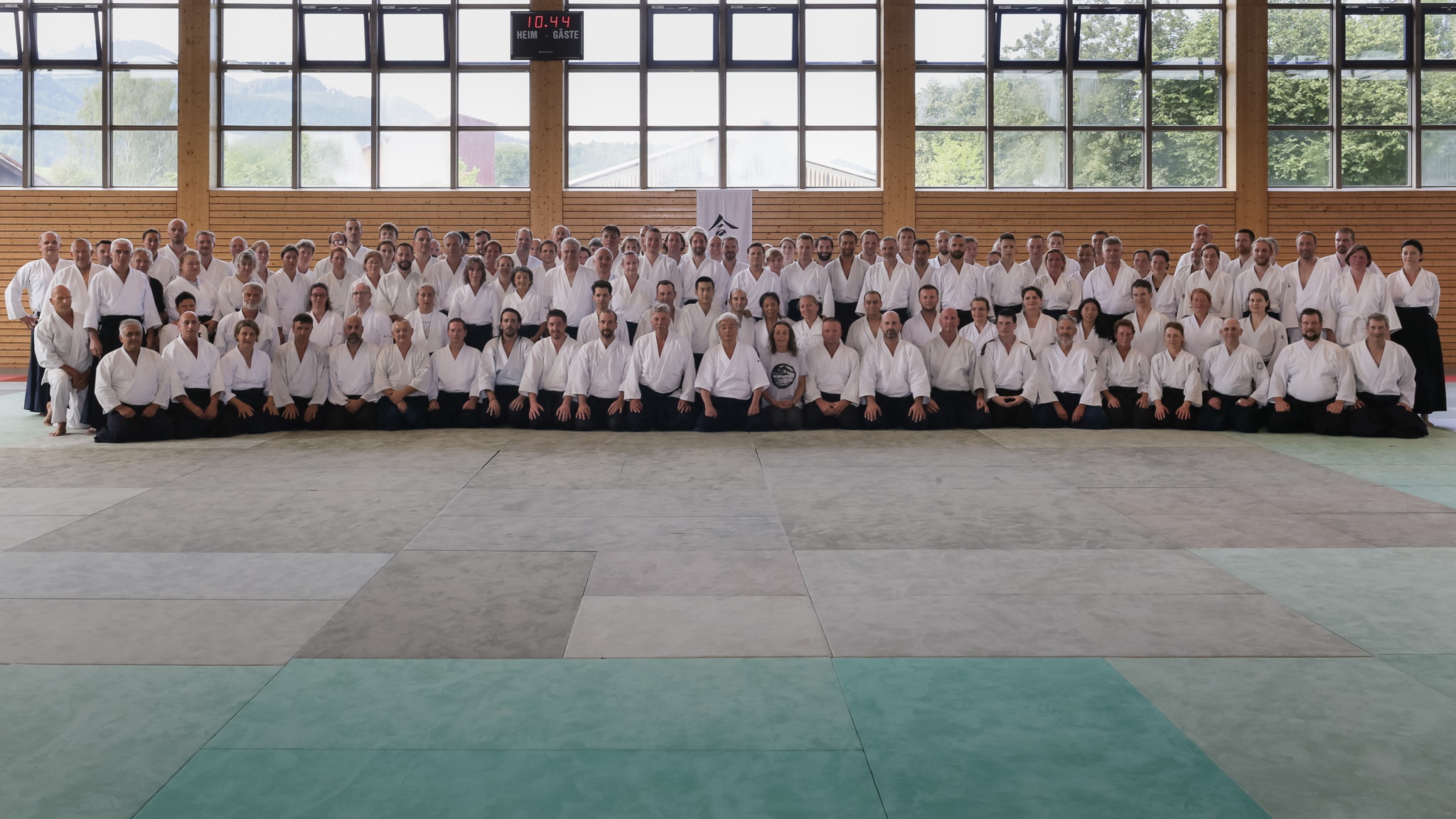
Bernau Seminar 2017.
VI
Interaction
The prolog of the script for the first Yoga teacher training (2008) says: (…) „Apart from understanding the basics of human anatomy, physiology and Yoga philosophy it is our goal to learn the art of living as a Yogi. To understand social behavior and man’s behavior towards nature as an integral part of human life.“
Sociality is important to me, in our Dōjō as well as in life in general. Since I am the owner of the Dōjō sometimes I have to exert authority and take decisions. On the other hand I am interacting with the members of my Dōjō, committing myself to them and trying to anticipate any problems.
As the managing director of a small business I negotiate with banks and our landlord. I also put great emphasis on talking with my Aikidō and Yoga students. The social aspect matters to me. It can also be found in the »ai« of Aikidō – getting together, putting together, converging. These abilities are vital for our Dōjō, not just for good Aikidō techniques.
VII
Yoga and Aikidō – a short comparison
Yoga booms – takes a breath - and keeps on booming. People keep asking me: What is the difference between Aikidō and Yoga? Well, the most important difference is: Although Yoga is practiced in a group you do not have any direct partner like in Aikidō. And the partner in Aikidō becomes active. He or she practices well or poorly, is a beginner or already experienced, can be aggressive or in a good and positive mood. That makes training more difficult, but also more honest. You have physical contact with your partner, some people do not like this. Taking your first steps in Aikidō is not easy and it takes some patience. Classic Yoga is based on the effect of tension and relaxation, on stretching of muscles and its healing effect on the fascial system and muscle tension due to stress, just to mention one aspect. After the first Yoga lesson people might already feel relaxed and refreshed. Perhaps even recharged with energy. Aikidō has a similar impact on people after a while but the beginning is harder. Everybody knows about Yoga, it does not take much explanation. Yoga is socially accepted, is popular like soccer (plus: you cannot lose in Yoga). It meets the expectations of our time and is a mainstream trend. Many celebrities like actors and top athletes practice Yoga, it is part of manager seminars etc. health insurers promote Yoga as a means of prevention, that implies trustworthiness. Usually Aikidō does not get all this publicity. Even though, sometimes some of my students change from Yoga to Aikidō or practice both. That is publicity in my own Dōjō, things could not work out better….
After a seminar for Yoga beginners or after the first Aikidō lessons the students have not yet accomplished much. Some keep asking if there is more to be attained? Well, Yoga might “unveil“ all illusions and help you gain an unblurred view on reality, poetically spoken. Aikidō aims at an all- encompassing „freedom“.
In our Dōjō there are about as many male as female Aikidōka. There are even more female Aikidō teachers than male. Yoga currently still attracts more women but the percentage of men keeps increasing. The jobs of the female members vary greatly, often they work in the medical sector or in education. Male members are executives, work in creative jobs or in the IT sector.
Now, Shusoku Dōjō celebrates its 25th anniversary. As always in life, there were ups and downs, but fortunately more ups than downs. And of course after the jubilee we will carry on with renewed energy and spirit.
